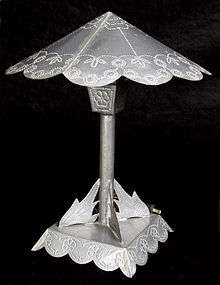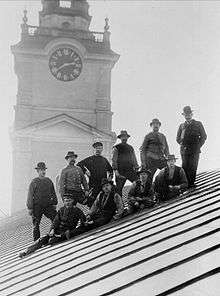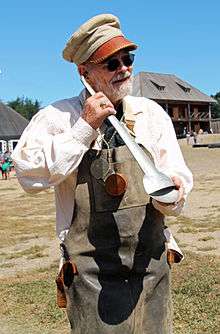Tinsmith
A tinsmith, sometimes known as a tinner, tinker, tinman, or tinplate worker is a person who makes and repairs things made of tin or other light metals. By extension it can also refer to the person who deals in tinware, or tin plate.[1] Tinsmith was a common occupation in pre-industrial times.


Unlike blacksmiths (who work mostly with hot metals), tinsmiths do the majority of their work on cold metal (although they might use a hearth to heat and help shape their raw materials). Tinsmiths fabricate items such as water pitchers, forks, spoons, and candle holders.
Training of tinsmiths
The tinsmith learned his trade, like many other artisans, by serving an apprenticeship of 4 to 6 years with a master tinsmith. Apprenticeships were considered "indentures" and an apprentice would start out first with simply cleaning the shop, polishing tools, keeping the fires lit, filing sharp edges and polishing finished pieces. Later he would trace patterns on sheets and cut them out, then soldering joints, and inserting rivets. Finally, he was allowed to cut out and complete objects.[2] He learned first to make cake stamps (cookie cutters), pill boxes and other simple items. Next, he formed objects such as milk pails, basins, or cake and pie pans. Later he tackled more complicated pieces such as chandeliers and crooked-spout coffee pots.
After his apprenticeship was completed, he then became a journeyman, not yet being a master smith employing others. Many young tinsmiths took to the road as peddlers or tinkers in an effort to save enough money to open a shop in town.
Raw material
Tinplate consists of sheet iron coated with tin and then run through rollers. This process was first discovered in the 16th century, with the development of British tinplate address in 1661 with a patent to Dud Dudley and William Chamberlayne.[3] Previously Great Britain had imported most tinplate from Hamburg.
The British Iron Act of 1750 prohibited (among other things) the erection of new rolling mills, which prevented the erection of new tinplate works in America until after the American Revolution. Certificates submitted by colonial governors to the British Board of Trade following the Act indicate that no tinplate works then existed though there were several slitting mills, some described as slitting and rolling mills.
Pure tin is an expensive and soft metal and it is not practical to use it alone. However, it could be alloyed with lead and copper to make pewter or alloyed with copper alone to produce bronze. Today's tinplate is mild steel electroplated with tin. Tin's non-rusting qualities make it an invaluable coating. However, tinplate's quality depends on the iron or steel being free from rust and the surface tin an unbroken coating. A piece of tinware may develop rust if the tin coating has worn away or been cut in the metal. The respective properties of the metals mean that corrosion once started is likely to be rapid.
Tinsmithing tools
The simple shapes made by the tinsmith require tools similar to those of a coppersmith. In addition to the big shears anchored in a hole in his bench he used hand snips and nippers for cutting. The tin was flattened on an anvil made of a block of steel. Straight and curved anvils (stakes) were used to turn and roll the edges of the tin. Solder was then used to join the pieces together; a soldering iron and fire pot were needed to do this.
Hammers are essential. Planishing hammers, chasing hammers, creasing hammers and setting down hammers are among the most common, as well as ball peen hammers. Horn or wooden mallets are also used. Before electric soldering irons became available, tinsmiths would use heated "copper" irons made of a wooden handle, iron shank and copper tips formed into different shapes. These items were heated in small furnaces, covered in sal ammoniac, and then used for soldering seams.[4]
History of tinsmithing

Tinwares were being produced in London by the 1630s, being known as Crooked Lane Wares (from the street where they were made).[5] The Worshipful Company of Tin Plate Workers were incorporated as a separate London Livery Company in 1670. However, tinplate workers were widespread.
The tinsmith has been plying his trade in America since 1720. Colonial tinsmiths used tinplate, wire, solder, and a few simple tools to produce their wares. When tinplate was finally produced in America in the early 19th century the products of the tinsmith became more widely available. They in turn saw an increase in demand and a need to speed up production. This brought about the development of many ingenious hand powered machines which sped up production and helped the tinsmith meet the demands for his products. The goods were "brought to market" by peddlers.[6]
Tinware was a popular folk art in colonial Mexico and New Mexico, and continues to be made there by local artisans today.
An annual tinsmith convergence is held every year in June.[7]
References
- "tinsmith definition". dictionary.com.
- Kauffman, Henry J. American Copper & Brass. Masthof Press, Morgantown, Pa. 1968. ISBN 1-883294-22-3
- Richards, Alun John. Tinplate in Wales. Llygad Gwalch, Ysgubor Plas, Llwyndyrys. 2008. ISBN 978-1-84524-125-4
- Lelegren, Shay. The Complete Tinsmith & Tinman's or Tinner's Trade. Tinsmith Museum of America, 2016. www.hotdiptin.com
- Minchinton, Walter E. (1957). The British tinplate industry: a history. Oxford, England: Clarendon Press. p. 3.
- "E Pattison - Tinsmith". Ulster American Folk Park. National Museum of Northern Island. Retrieved 8 March 2016.
- "Tinsmith". www.tintinkers.org.